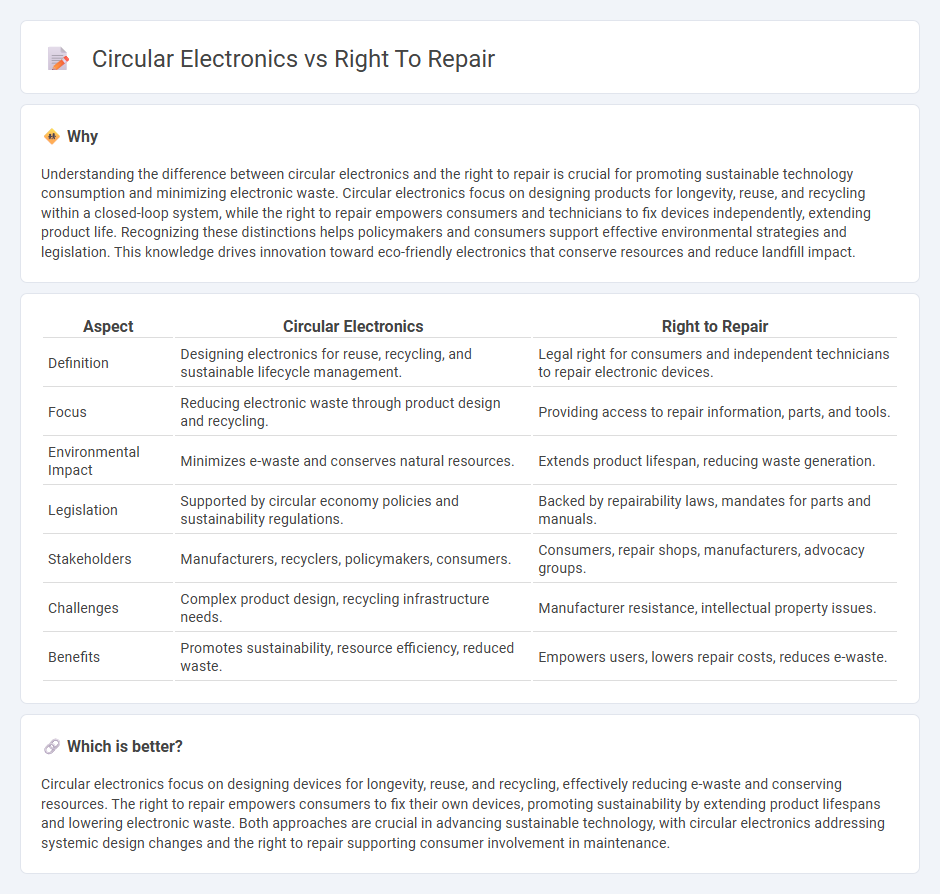
Circular electronics focus on designing devices for durability, reuse, and recycling, minimizing electronic waste and environmental impact. The right to repair movement advocates for consumers' ability to fix and modify their devices, promoting sustainability and reducing reliance on manufacturer services. Explore the intersection of these concepts to understand how they reshape sustainability in technology.
Why it is important
Understanding the difference between circular electronics and the right to repair is crucial for promoting sustainable technology consumption and minimizing electronic waste. Circular electronics focus on designing products for longevity, reuse, and recycling within a closed-loop system, while the right to repair empowers consumers and technicians to fix devices independently, extending product life. Recognizing these distinctions helps policymakers and consumers support effective environmental strategies and legislation. This knowledge drives innovation toward eco-friendly electronics that conserve resources and reduce landfill impact.
Comparison Table
| Aspect | Circular Electronics | Right to Repair |
|---|---|---|
| Definition | Designing electronics for reuse, recycling, and sustainable lifecycle management. | Legal right for consumers and independent technicians to repair electronic devices. |
| Focus | Reducing electronic waste through product design and recycling. | Providing access to repair information, parts, and tools. |
| Environmental Impact | Minimizes e-waste and conserves natural resources. | Extends product lifespan, reducing waste generation. |
| Legislation | Supported by circular economy policies and sustainability regulations. | Backed by repairability laws, mandates for parts and manuals. |
| Stakeholders | Manufacturers, recyclers, policymakers, consumers. | Consumers, repair shops, manufacturers, advocacy groups. |
| Challenges | Complex product design, recycling infrastructure needs. | Manufacturer resistance, intellectual property issues. |
| Benefits | Promotes sustainability, resource efficiency, reduced waste. | Empowers users, lowers repair costs, reduces e-waste. |
Which is better?
Circular electronics focus on designing devices for longevity, reuse, and recycling, effectively reducing e-waste and conserving resources. The right to repair empowers consumers to fix their own devices, promoting sustainability by extending product lifespans and lowering electronic waste. Both approaches are crucial in advancing sustainable technology, with circular electronics addressing systemic design changes and the right to repair supporting consumer involvement in maintenance.
Connection
Circular electronics promotes sustainable product lifecycle management by encouraging design for durability, reparability, and recycling to reduce electronic waste. The right to repair movement supports this model by advocating for consumer access to repair information, tools, and spare parts, enabling longer device usage. Together, they drive environmental benefits through minimized resource extraction and decreased landfill waste.
Key Terms
Product Design
Product design plays a pivotal role in the intersection of right to repair and circular electronics by emphasizing modularity, ease of disassembly, and use of standardized components to extend product lifespan and reduce electronic waste. Incorporating repair-friendly features, such as accessible screws and replaceable batteries, aligns with sustainability goals and enhances consumer empowerment under right to repair laws. Explore further how innovative design principles are transforming electronics for a more sustainable future.
Supply Chain Transparency
Right to repair legislation enhances supply chain transparency by mandating manufacturers to provide accessible repair information and spare parts, fostering ethical sourcing and reducing electronic waste. Circular electronics rely on transparent supply chains to facilitate product refurbishment, component reuse, and material recycling, promoting sustainable resource management. Explore how supply chain transparency bridges right to repair and circular electronics for a greener technological future.
E-waste Management
The right to repair empowers consumers and technicians to fix electronic devices, significantly reducing e-waste by extending product lifespans. Circular electronics emphasize designing products for easy disassembly, reuse, and recycling, promoting a sustainable lifecycle that minimizes environmental impact. Explore how these strategies collectively transform e-waste management and foster a greener future.
Source and External Links
Right To Repair - A Growing Trend for States Creating Compliance Challenges for Manufacturers - Right to Repair laws in multiple U.S. states require manufacturers to provide consumers and independent repair providers with access to tools, parts, and repair information under fair and reasonable terms, facilitating easier product repairs without relying solely on original manufacturers.
Learn About the Right to Repair - Right to Repair legislation ensures consumers and independent repair shops can access repair documentation, tools, parts, and firmware equally, securing consumer choice and supporting competitive local repair markets while protecting manufacturers' intellectual property rights.
iFixit: Repair is noble - The Right to Repair movement advocates for consumers' ability to repair their own devices by accessing necessary parts, tools, manuals, and software, counteracting manufacturer monopolies and supporting independent repair businesses.
 dowidth.com
dowidth.com